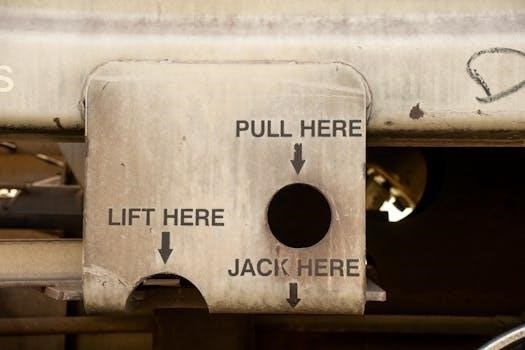Manual Handling Risk Assessment⁚ Key Components
Manual handling risk assessments are crucial for identifying and mitigating risks associated with physical tasks․ They involve analyzing hazards, assessing risk levels, and implementing control measures to ensure employee safety, as well as compliance with regulations․
What is a Manual Handling Risk Assessment?
A manual handling risk assessment is a systematic process used to identify and evaluate the potential hazards associated with manual handling tasks․ These tasks include lifting, carrying, pushing, pulling, and any other activities that involve physical effort․ The primary goal of this assessment is to protect workers from injuries and illnesses by identifying risks before they cause harm․ It involves a thorough analysis of the task, the load, the working environment, and the individual performing the task․ The assessment aims to determine the level of risk and implement appropriate control measures to reduce or eliminate those risks․ This process is a crucial component of workplace safety, ensuring a healthier and safer work environment for all employees involved in manual handling operations․ It’s not just about compliance; it’s about proactively safeguarding the well-being of workers․
Legal Requirements for Manual Handling Risk Assessments
In the UK, conducting manual handling risk assessments is a legal requirement under several pieces of legislation designed to protect workers’ health and safety․ The Manual Handling Operations Regulations 1992 (MHOR) specifically address manual handling, requiring employers to avoid hazardous manual handling operations where reasonably practicable․ If avoidance isn’t possible, a risk assessment must be conducted to evaluate the risks involved, and control measures must be implemented to reduce those risks to the lowest level reasonably practicable․ The Health and Safety at Work etc Act 1974 also places a general duty on employers to ensure the health, safety, and welfare of their employees at work․ Furthermore, the Management of Health and Safety at Work Regulations 1999 mandates that employers must conduct suitable and sufficient risk assessments for all work activities, including manual handling․ These regulations collectively emphasize the importance of proactive risk management in preventing manual handling-related injuries․

Manual Handling Risk Assessment Templates
Templates provide structured frameworks for conducting manual handling risk assessments, aiding in systematic hazard identification, risk evaluation, and control measure implementation․ They ensure consistency and thoroughness․
Free Templates and Customization

Numerous free manual handling risk assessment templates are available online, offering a starting point for businesses․ These templates often include sections for task details, hazard identification, risk evaluation, and control measures․ However, it’s crucial to remember that these templates are not one-size-fits-all․ Customization is essential to tailor them to your specific workplace, tasks, and equipment․ You should always personalize the template to reflect your unique operational environment․ This involves adding specific details about your processes, potential hazards, and the control measures relevant to your business․ Modifying free templates ensures they accurately capture the risks and control strategies relevant to your work environment․ Utilizing a flexible template builder can further streamline this process, allowing you to add input fields and modify sections with ease․ Customizing a template is vital for an effective assessment․
Key Components of a Template
A robust manual handling risk assessment template should include several key components to ensure thorough evaluation․ Firstly, it needs a section for basic assessment details, like the location of work, the date, and who conducted the assessment․ Then, a detailed description of the task being assessed is vital, including the size and weight of loads, as well as the lifting methods․ Identifying potential hazards is another key component, such as awkward postures, repetitive movements, and environmental factors․ A risk matrix is necessary to calculate risk scores by considering the likelihood and severity of hazards․ Crucially, the template should have space for detailing control measures, such as use of equipment, or changes in work method․ Finally, it should include the new residual risk rating after these control measures have been implemented, with a review date․

Risk Identification and Control Measures
Identifying manual handling hazards and implementing control measures are essential steps to protect workers․ This involves assessing tasks, recognizing risks, and putting suitable safeguards in place to minimize potential injuries․
Identifying Manual Handling Hazards
Identifying manual handling hazards is a critical step in any risk assessment process․ This involves a careful examination of all tasks that require physical exertion, such as lifting, carrying, pushing, pulling, or supporting loads․ It’s crucial to observe workers performing these tasks to spot potential dangers․ Look for factors like awkward postures, repetitive movements, excessive force, and long distances over which loads need to be moved․ The weight and size of the load itself also pose risks․ Environmental factors such as uneven surfaces, poor lighting, and confined spaces should be taken into consideration․ Furthermore, consider the characteristics of the load, such as its stability, shape, and if it has sharp or hot edges․ Finally, always remember to document every potential hazard that is discovered during the assessment process․
Implementing Control Measures
Implementing effective control measures is essential after identifying manual handling hazards․ The primary goal is to reduce the risk of injury to the lowest possible level․ This process begins by considering ways to eliminate the need for manual handling altogether, which is the most effective method․ If elimination is not feasible, focus on reducing the risks using a hierarchy of controls․ This might include using mechanical aids such as trolleys, hoists, or conveyors to assist with lifting and moving loads․ Modifying the task to minimize the physical demands of the job is another important control․ Training workers on proper manual handling techniques is vital, including safe lifting methods and posture․ Furthermore, providing appropriate personal protective equipment can also provide additional protection․ Remember that regular reviews of control measures are necessary to ensure their continued effectiveness․

Who Needs a Manual Handling Risk Assessment?
Employers must conduct risk assessments for any manual handling tasks․ Health and safety personnel and contractors also require these assessments to ensure workplace safety and adherence to legal guidelines․
Employers and Their Responsibilities
Employers bear the primary responsibility for ensuring the health, safety, and welfare of their employees, particularly concerning manual handling tasks․ This includes conducting thorough risk assessments to identify potential hazards associated with lifting, carrying, pushing, and pulling activities․ They must also provide a safe working environment, proper training, and adequate information to enable employees to perform their jobs safely․ Employers are obligated to avoid manual handling operations that pose a risk of injury whenever reasonably practicable․ If avoidance isn’t feasible, they should assess the risks and reduce them to the lowest level possible․ Compliance with regulations like the Manual Handling Operations Regulations 1992 and the Health and Safety at Work etc Act 1974 is crucial․ Ultimately, employers are accountable for creating a workplace where the risk of injury from manual handling is minimized, and staff are well-protected․
Contractors and Site Safety
Contractors also have significant responsibilities regarding manual handling risk assessments when working on a client’s site․ Typically, contractors are required to conduct their own risk assessments before commencing any manual handling tasks․ This ensures they adhere to health and safety procedures and understand the potential hazards involved in their work․ It’s important for contractors to align with the client’s safety protocols and site-specific requirements, demonstrating their commitment to workplace safety․ If a contractor fails to conduct a proper risk assessment or does not follow safety guidelines, they could be held liable for any injuries that may occur․ This underscores the importance of pre-planning, risk evaluation, and the implementation of control measures by contractors to safeguard themselves and others on-site․ Ultimately, a collaborative approach between contractors and site management is vital for maintaining a safe working environment․